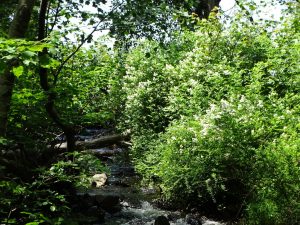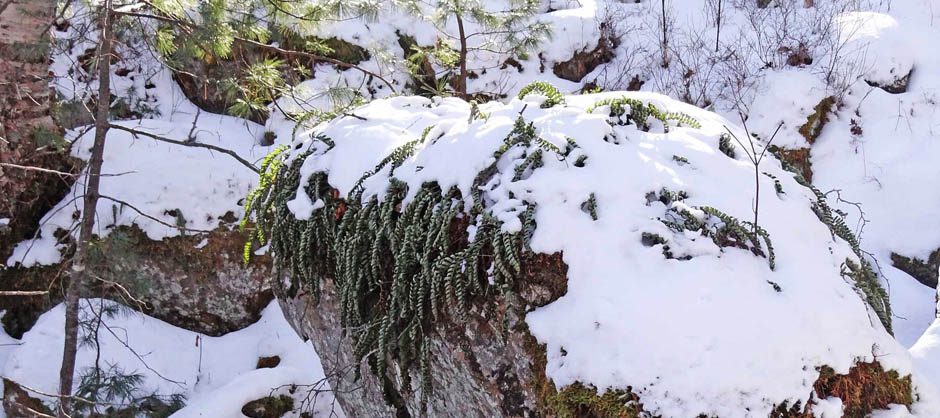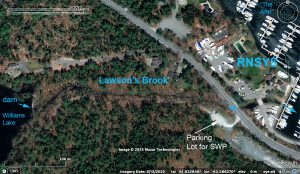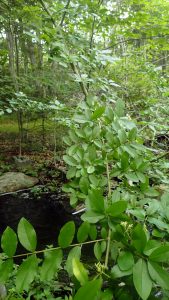| UPDATE Aug 18, 2023: The NS Invasive Species Council has recently released their new Grow Me Instead guidebook in which Japanese Barberry and Common Barberry are cited as potential invasives in NS & NB; they suggest alternative native species to grow in their stead in our gardens. |
Lawsons Brook is the stream that drains Williams Lake. It begins at the dam on Williams Lake and falls about 15 meters in elevation over the approx. 365 m from the dam to the point it enters a Culvert taking it below Purcells Cove Road; then it continues over another 80 m through Royal Nova Scotia Yacht Squadron grounds before finally discharging into “The Arm”.
Lawsons Brook is lined by magnificent hardwood-dominated, old forest. Yellow Birch is the most prominent species, followed by Red Oak, Red Maple, White Pine, Black Spruce and the occasional Eastern Hemlock; and distinct sub-canopies formed by Striped Maple and Witch Hazel.
The ground is very uneven, bouldery, with lots of woody debris; near the dam, there are several channels through low-lying floodplain/wetland (and a plethora of poison ivy).
In our 2013 survey of the Williams Lake Backlands*, Nick Hill and I traversed the area many times and noted only two invasive plant species – Japanese Knotweed and Japanese Barberry – those only on or by Lawsons Brook and only close to Purcell’s Cove Road
*Ecological Assessment of the Plant Communities of the Williams Lake Backlands, *by Nick Hill and David Patriquin. 2013. Report to Williams lake Conservation Company.

Multilfora Rose on Lawsons Brook, just below the dam on July 7, 2023
In the spring of 2021, I observed small Multiflora Rose plants just below the dam and near Purcells Cove Road (view Post, June 13, 2021). Williams Lake Conservation Company member Melanie Dobson cut those plants back at the time, but by July of this year there was massive regrowth of the Multiflora Rose just below the dam.
To get a better sense of the state of Multiflora Rose and other invasive species on Lawsons Brook, on July 20, 2023 I walked the south side of the Brook from Purcell’s Cove Road to Williams Lake and noted and photographed every separate occurrence of any exotic (non-native) plant species lying within a minimum of 10 m from the Brook on the south side; and any occurrence close to the bank on the north side. (Because water was running fast and furious – after a lot of rain in June and July – I couldn’t cross the brook). On that day and a couple of follow-up days, I recorded a total of 24 separate occurrences of 4 invasive species:
Japanese Barberry – 10 observations
Multiflora Rose – 7 0bservations
Japanese Knotweed – 5 observations
Border Pivet – 2 observations
For details, view Exotic & Invasive plant species on Lawsons Brook.

Clump of Japanese Barberry, approx 3 x 1.5 m oriented along the Brook. View iNaturalist Record
To my surprise, Japanese Barberry and not Multiflora Rose was the most abundant and most widely distributed of the 4 species. It typically occurred in dense patches or thickets on the banks of the brook.
I suspect that such thickets suppress recruitment of native trees and shrubs such as Yellow Birch, Red Maple, Red Oak, Striped Maple, Witch Hazel and Hobble Bush; as well as ground herbs such as Wild Sasparilla (Aralia nudicaulis) and Canada Mayflower (Maianthemum canadense).
Currently there are only 3 records on iNaturalist of Japanese Barberry in other areas of the Backlands, but it’s pretty likely there are more occurrences. It is clearly a species we should be on the lookout for more broadly within the Backlands and probably elsewhere.
Multiflora Rose and Japanese Knotweed are well known, widespread invasive plant species in NS, and both are listed as invasives by the Nova Scotia Invasive Species Council (NSISC). Japanese Barberry, however is not currently (Aug 7, 2023) listed as a common invasive species nor is it cited in the NSISC Invasive Species Guide as a “potential” invasive species for NS.*
 New Guidebook from NSISC. It describes native alternatives to commonly used garden plants that are invasive in our region. *UPDATE Aug 18, 2023: I sent a note to NSISC this a.m. suggesting they add J. Barberry to their list of invasive species and received this reply: “… Yes, we do consider Japanese Barberry invasive. It is listed as invasive in our new Grow Me Instead guidebook. ” Indeed, it’s a really excellent guide, just released (July 18, 2023); it is currently cited and available under News and Events on the NS Invasive Species Council website. It focusses specifically on NB & NS/The Wabanaki Forest Region. “This guide is a reference tool for New Brunswick and Nova Scotia gardeners to learn about invasive horticultural plants and their recommended native alternatives…For each invasive plant highlighted in this guide, two native alternatives are recommended along with details about their characteristics and preferred growing conditions, uses in a garden, and additional interesting information.” |
Japanese Barberry is known as an Invasive Species in other areas of NA – e.g. in my bookshelf reference: Invasive Plants: a Guide to Identification, Impacts and Control of Common North American Species by SR Kaufman and W. Kaufman, Stackpole Books, 2007. (There is 3rd Ed. – 2023).
The Kaufmans note that “Japanese Barberry prefers partial sunlight but also does well in shade, especially in younger forests.”
Under “WHAT IT DOES IN THE ECOSYSYTEM” the Kaufmans write “Birds…eat barberries and spread seeds far and wide… [It] can also grow from root creepers or from branches rooting on contact with the ground. This enables a single branch to form a thicket. Japanese Barberry at high densities lowers plant diversity, and the leaf litter causes changes in soil chemistry.”
Another surprise in the survey was the occurrence of large Privet shrubs (Ligusticum sp.) at 2 sites by the water in the upper reaches of Lawsons Brook. Like Japanese Barberry, Privets are not listed as invasives by the Nova Scotia Invasive Species Council or cited as a species to look out for, but they are known as invasives elsewhere.
Japanese Knotweed and Multiflora Rose are species that were planted as ornamentals in the late 1800s/early 1900s that “escaped cultivation”; they are no longer promoted as ornamentals today. Japanese Barberry and Privets are very common hedge species in the Halifax area today, so no surprise, perhaps, that we are seeing them in the wild. At some point we may want to stop promoting/using these plants horticulturally.
| UPDATE (Aug 18, 2023) : Indeed, as noted above, the NSISC is now advising just that – see their new Grow Me Instead guidebook. ” About Barberry they comment: Both JAPANESE and COMMON BARBERRY are woody shrubs with thorny branches. They have creeping roots and a variety of animals disperse their seeds. This allows them to easily escape cultivation and form dense thorny thickets that out-compete native plant species for resources. Dense thickets of Japanese barberry also create the optimal conditions for black-legged ticks, and the presence of this shrub has been linked with an increased risk of Lyme disease.” They suggest as alternatives Northern Bush Honeysuckle (Diervilla lonicera) and Sweet-fern (Comptonia peregrina). Interestingly, Northern Bush Honeysuckle occurs along Lawson’s Brook; we wouldn’t expect to find Sweet-fern there because of the shade and usually high soil moisture, but it does occur in drier, partially open areas along the single-track trail through the Shaw Wilderness Park.
The Barberry by Lawsons Brook appears to be Japanese barberry rather than the Common Barberry, based on their untoothed leaf margins – see Ohio State Univ. Extension doc Invasive Species Management: Common and Japanese Barberry |
I don’t have a ready answer about what what we should do about the invasive plants on Lawsons Brook. Williams Lake Conservation Company member Melanie Dobson isn’t waiting around while we all think about it, and has been cutting back Multiflora Rose and Japanese Knotweed on Lawsons Brook and elsewhere in the Williams Lake area. With some coordinated effort and continued monitoring/cutting back, we probably could tip the balance back in favour of native species.
Regardless, I think we should be monitoring the Backlands at large for invasive plants and, wherever possible, remove them or cut them back (and continue to monitor and cut back any regrowth) before they become abundant. That’s the most non-labour-intensive option. Once the invasive plants become well established, it’s much more labour-intensive to attempt to eliminate them.
Some Related Pages and Posts on backlandscoalition.ca
Exotic and Invasive Plants
Subpages:
- Rosa multiflora
- Exotic & Invasive plant species on Lawsons Brook
- Governor’s Brook/Mac Run Barrens
- Definitions
- Lit & Links
- Invasive species in Nova Scotia
Invasive & Exotic Plants are making their way into the Backlands
Post, June 13, 2021
—–
Post by David Patriquin, Aug 17, 2023




